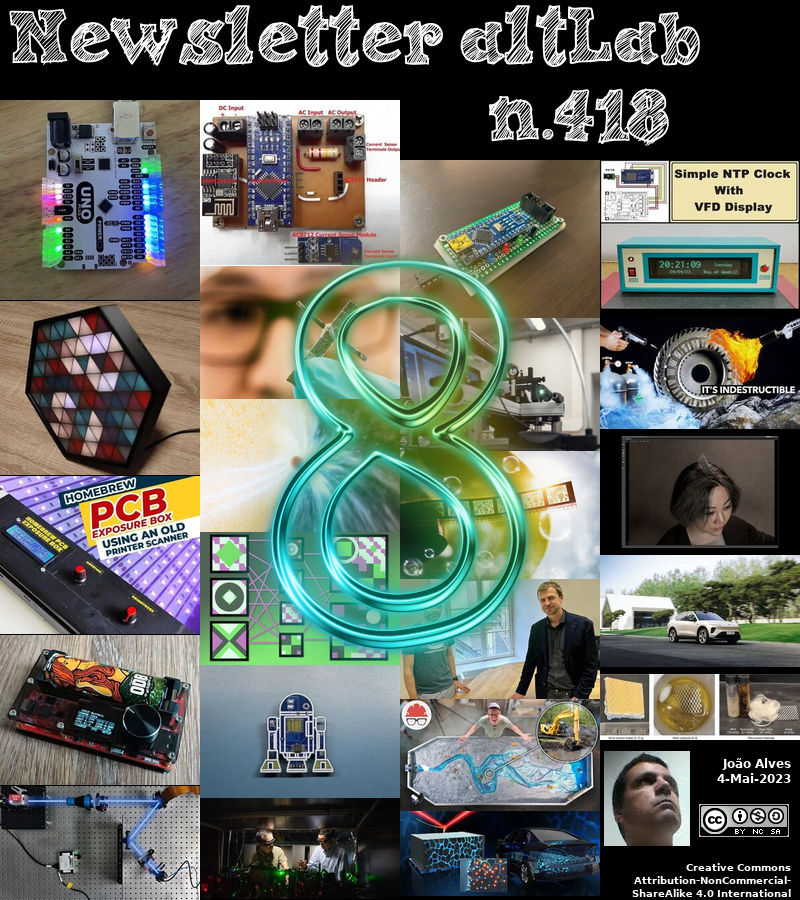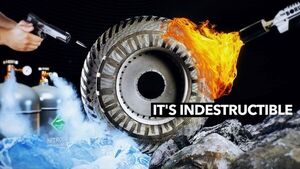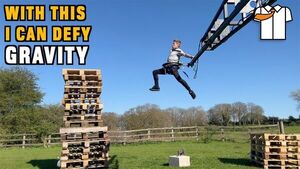2023-05-04 - Nº 418
Editorial
Esta é a Newsletter Nº 418 que se apresenta com o mesmo formato que as anteriores. Se gostar da Newsletter partilhe-a!
Todas as Newsletters encontram-se indexadas no link.
Esta Newsletter tem os seguintes tópicos:
Faz hoje anos que nascia, em 1655, o inventor italiano Bartolomeo Cristofori. Ele é responsável pela invenção do piano. Ele era fabricante de cravos e em determinada altura resolveu modificar um desses instrumentos e substituir as penas utilizadas no interior do instrumento por pequenos martelos, criando uma bela melodia e que trouxe mais vida às músicas tocadas por ele.
Faz também hoje anos que nascia, em 1733, o matemático e astrónomo náutico francês Jean-Charles de Borda. Ele é conhecido pelos seus estudos de mecânica dos fluidos e pelo desenvolvimento de instrumentos de navegação e de geodesia, o estudo da dimensão e da forma da Terra. Borda entrou para a marinha, participou em várias viagens científicas e desempenhou um papel na Guerra da Independência Americana. Foi um dos principais impulsionadores da introdução do sistema decimal. Borda utilizou o cálculo e a experimentação para unificar os domínios da física. Para os seus trabalhos de topografia, desenvolveu também uma série de tabelas trigonométricas. Em 1782, quando comandava uma flotilha de seis navios franceses, foi capturado pelos britânicos. A saúde de Borda piorou após a sua libertação. É um dos 72 cientistas homenageados com placas na Torre Eiffel.
Faz igualmente hoje anos que nascia, em 1806, o inventor inglês William Fothergill Cooke. Ele trabalhou com Charles Wheatstone no desenvolvimento da telegrafia eléctrica. Da dupla, Cooke contribuiu com uma capacidade comercial superior, enquanto Wheatstone é geralmente considerado o mais importante dos dois na história do telégrafo. Depois de Cooke ter assistido a uma demonstração da utilização do fio na transmissão de mensagens, iniciou as suas próprias experiências com telegrafia (1836) e formou uma parceria com Wheatstone. A sua primeira patente (1837) era impraticável devido ao custo. Demonstraram o seu telégrafo de cinco agulhas em 24 de Julho de 1837, quando fizeram funcionar uma linha telegráfica ao longo da linha férrea de Euston a Camden Town, capaz de transmitir e receber com êxito uma mensagem. Em 1845, patentearam um telégrafo eléctrico de agulha única.
Faz também hoje anos que nascia, em 1845, o filósofo e matemático britânico William Kingdon Clifford. Ele desenvolveu a teoria dos biquaterniões (uma generalização da teoria dos quaterniões do matemático irlandês Sir William Rowan Hamilton) e que depois a associou a álgebras associativas mais gerais. Em 1870, sobreviveu a um naufrágio perto da Sicília quando se encontrava numa expedição a Itália para obter dados científicos de um eclipse. Influenciado pelos trabalhos de Riemann e Lobachevsky, Clifford estudou a geometria não-euclidiana. Em 1870, escreveu a obra On the Space Theory of Matter, na qual defende que a energia e a matéria são simplesmente diferentes tipos de curvatura do espaço. Neste trabalho, apresentou ideias que viriam a desempenhar um papel fundamental na teoria geral da relatividade de Einstein.
Faz igualmente hoje anos que nascia, em 1874, o engenheiro electrotécnico norte-americano Frank Conrad. Ele, devido ao seu interesse pela radiotelefonia, criou a primeira estação de rádio comercial. Conrad trabalhou para a Westinghouse como engenheiro-chefe assistente na fábrica de East Pittsburgh e adquiriu mais de 200 patentes durante a sua vida. Como amador, tendo construído uma estação de transmissão no segundo andar da garagem atrás da sua casa em Wilkinsburg, Pensilvânia, quando substituiu o microfone por um fonógrafo, descobriu uma grande audiência de ouvintes que tinham construído os seus próprios aparelhos de rádio de cristal e que, ao ouvirem a música, escreviam ou telefonavam a pedir mais música e notícias. Quando ficou sobrecarregado com esses pedidos, decidiu transmitir programas regulares e programados para satisfazer os seus ouvintes. Foi ele quem cunhou o termo "transmissão".
Faz também hoje anos que nascia, em 1899, o industrial alemão do sector automóvel Fritz von Opel. Ele participou, com Max Valier e Friedrich Wilhelm Sander, em experiências de propulsão por foguetões para automóveis e aviões. Em 11 de Abril de 1928, em Berlim, testaram o primeiro foguetão automóvel tripulado. Em 30 de Setembro de 1929, von Opel pilotou o Opel Sander Rak.1, um planador equipado com 16 foguetões de 50 libras de impulso cada, e fez um voo bem sucedido de 75 segundos, cobrindo quase 2 milhas perto de Frankfurt-am-Main, Alemanha, com Von Opel como piloto. Ao patrocinar estes primeiros testes de transporte com foguetões, a Opel popularizou a ideia da propulsão por foguetões na Alemanha.
Faz igualmente hoje anos que nascia, em 1926, o físico canadiano-americano D. Allan Bromley. Ele é considerado o "pai da moderna ciência dos iões pesados" pelas suas experiências pioneiras sobre a estrutura e a dinâmica dos núcleos atómicos. Foi um dos líderes no desenvolvimento de sistemas de detecção de aceleradores de partículas e de sistemas de aquisição e análise de dados por computador. Enquanto esteve na Atomic Energy of Canada (1955-60), instalou o primeiro acelerador tandem Van Der Graaff. Foi fundador e director (1963-89) do Laboratório de Estrutura Nuclear A.W. Wright na Universidade de Yale, que produziu mais físicos nucleares experimentais do que qualquer outra instalação. Durante este período, tornou-se activo em numerosos conselhos de política científica nacionais e internacionais. De 1980 a 1989, foi membro do Conselho Científico da Casa Branca.
Por fim, faz hoje anos que nascia, em 1931, o engenheiro electrotécnico e inventor coreano-americano Dawon Kahng. Ele é conhecido pelo seu trabalho em electrónica de estado sólido. É mais conhecido por ter inventado o MOSFET (transístor de efeito de campo metal-óxido-semicondutor, ou transístor MOS), juntamente com o seu colega Mohamed Atalla, em 1959. Kahng e Atalla desenvolveram os processos PMOS e NMOS para o fabrico de dispositivos semicondutores MOSFET. O MOSFET é o tipo de transístor mais utilizado e o elemento básico da maioria dos equipamentos electrónicos modernos. Mais tarde, Kahng e Atalla propuseram o conceito de circuito integrado MOS e realizaram trabalhos pioneiros sobre díodos Schottky e transístores de base nanométrica no início da década de 1960. Kahng inventou então o MOSFET de porta flutuante (FGMOS) com Simon Min Sze em 1967. Kahng e Sze propuseram que os FGMOS pudessem ser utilizados como células de memória de porta flutuante para memória não volátil (NVM) e memória só de leitura reprogramável (ROM), que se tornaram a base das tecnologias EPROM (erasable programmable ROM), EEPROM (electrically erasable programmable ROM) e memória flash. Kahng foi introduzido no National Inventors Hall of Fame em 2009.
Em 1989, a sonda espacial Magellan foi transportada no compartimento de carga da missão STS-30 do vaivém espacial Atlantis, lançado do Centro Espacial Kennedy, na Florida. A sonda espacial foi baptizada com o nome do explorador português do século XVI, Fernão de Magalhães. Esta foi a primeira nave espacial planetária a ser lançada de um vaivém em órbita terrestre. Chegou à sua planeada órbita polar em torno de Vénus em 10 de Agosto de 1990, que circulou uma vez em cada 3 horas e 15 minutos. Enquanto o planeta girava lentamente por baixo, a Magellan recolheu imagens de radar da superfície em faixas com cerca de 17-28 km (10-17 mi) de largura e transmitiu a informação por rádio. A sua missão incluía a realização de outras medições. Em 11 de Outubro de 1994, foi direccionada para a superfície, recolhendo dados até se incendiar na atmosfera.
E faz hoje 8 anos que comecei esta publicação semanal de newsletters sobre assuntos interessantes. Foram 418 semanas sempre diferentes, em constante procura de temas e de artigos que a Internet nos traz e que são úteis de ser indexados aqui na newsletter. Ao longo destes oito anos foram publicados mais de 24000 artigos sobre todo o tipo de assuntos. Agradeço o apoio e as contribuições que me têm feito e continuarei a trabalhar com o objectivo de trazer ainda mais artigos e informação para esta audiência. E como é obrigação do dia "May the Fourth be with You!"
Na Newsletter desta semana apresentamos diversas noticias, artigos científicos, projetos de maker e alguns vídeos interessantes.
 João Alves ([email protected])
João Alves ([email protected])
O conteúdo da Newsletter encontra-se sob a licença  Creative Commons Attribution-NonCommercial-ShareAlike 4.0 International License.
Creative Commons Attribution-NonCommercial-ShareAlike 4.0 International License.
Novidades da Semana
Outras Notícias

New Study of Uranus’ Large Moons Shows 4 May Hold Water
"The work is based on new modeling and explores how oceans could exist in unlikely places in our solar system. Re-analysis of data from NASA’s Voyager spacecraft, along with new computer modeling, has led NASA scientists to conclude that four of Uranus’ largest moons likely contain an ocean layer between their cores and icy crusts. Their study is the first to detail the evolution of the interior makeup and structure of all five large moons: Ariel, Umbriel, Titania, Oberon, and Miranda. The work suggests four of the moons hold oceans that could be dozens of miles deep. In all, at least 27 moons circle Uranus, with the four largest ranging from Ariel, at 720 miles (1,160 kilometers) across, to Titania, which is 980 miles (1,580 kilometers) across. Scientists have long thought that Titania, given its size, would be most likely to retain internal heat, caused by radioactive decay." [...]

Latest NVIDIA Graphics Research Advances Generative AI’s Next Frontier
"NVIDIA will present around 20 research papers at SIGGRAPH, the year’s most important computer graphics conference. NVIDIA today introduced a wave of cutting-edge AI research that will enable developers and artists to bring their ideas to life — whether still or moving, in 2D or 3D, hyperrealistic or fantastical. Around 20 NVIDIA Research papers advancing generative AI and neural graphics — including collaborations with over a dozen universities in the U.S., Europe and Israel — are headed to SIGGRAPH 2023, the premier computer graphics conference, taking place Aug. 6-10 in Los Angeles. The papers include generative AI models that turn text into personalized images; inverse rendering tools that transform still images into 3D objects; neural physics models that use AI to simulate complex 3D elements with stunning realism; and neural rendering models that unlock new capabilities for generating real-time, AI-powered visual details. Innovations by NVIDIA researchers are regularly shared with developers on GitHub and incorporated into products, including the NVIDIA Omniverse platform for building and operating metaverse applications and NVIDIA Picasso, a recently announced foundry for custom generative AI models for visual design. Years of NVIDIA graphics research helped bring film-style rendering to games, like the recently released Cyberpunk 2077 Ray Tracing: Overdrive Mode, the world’s first path-traced AAA title." [...]

NIO and NXP Collaborate on 4D Imaging Radar Deployment
"NXP Semiconductors N.V. (NASDAQ: NXPI) today announced NIO Inc., a leading brand in the global premium smart electric vehicle market, will leverage NXP’s leading automotive radar technology, including its ground-breaking imaging radar solution. NXP’s latest 4D imaging radar solution is a powerful technology that allows benefits far beyond traditional radar. It will enable a significant improvement in front radar performance in today’s vehicles. The cars will be able to detect and classify objects such as other vehicles and vulnerable road users in high-way and complex urban scenarios and at distances of up to 300m, bringing more safety to the roads and driving comfort for end users. OEMs increasingly focus on the introduction of safety and convenience features to take autonomous driving services to the next level. NXP’s imaging radar technology expands radar’s capabilities from measuring range and speed, to include direction, angle of arrival, and elevation measurement." [...]

New toolchain and software package from STMicroelectronics ease development of edge processing with intelligent inertial sensors
"STMicroelectronics has released a toolchain and accompanying software package for programming the intelligent sensor processing unit (ISPU) embedded in the latest-generation intelligent MEMS IMUs, ISM330IS and LSM6DSO16IS. The toolchain and software help employ the ISPU to handle motion-related workloads such as activity recognition and anomaly detection directly in the sensor. This permits reducing system power and latency, offloading the local microcontroller, and uniquely specializing the behavior of the sensor to the application. Using the ISPU toolchain, developers can program the sensor’s intelligent processing unit using the familiar and widespread C programming language. They can choose to work from a command line interface (CLI) or an Eclipse-based environment like STM32CubeIDE, and to use a graphical user interface (GUI) such as AlgoBuilder and Unicleo. The X-CUBE-ISPU software package contains templates and example projects as well as ready-to-use libraries that help developers quickly understand how to use and program the sensors’ ISPU and can be used as a starting point to implement custom algorithms." [...]

30 years of a free and open Web
"Exactly 30 years ago, on 30 April 1993, CERN made an important announcement. Walter Hoogland and Helmut Weber, respectively the Director of Research and Director of Administration at the time, decided to publicly release the tool that Tim Berners-Lee had first proposed in 1989 to allow scientists and institutes working on CERN data all over the globe to share information accurately and quickly. Little did they know how much it would change the world. On this day in 1993, CERN released the World Wide Web to the public. Now, it is an integral feature of our daily lives: according to the International Telecommunications Union, more than 5 billion people, two thirds of the worldwide population, rely on the internet regularly for research, industry, communications and entertainment. “Most people would agree that the public release was the best thing we could have done, and that it was the source of the success of the World Wide Web,” says Walter Hoogland, co-signatory of the document that proclaimed the Web’s release, “apart from, of course, the World Wide Web itself!” Public domain: then and now The release of the World Wide Web was launched by an internal document, addressed “to whom it may concern” and signed by Hoogland and Weber." [...]
Ciência e Tecnologia

The Moon's heart revealed for the first time
"Fifty years after Apollo 11 paved the way for the first surveys of the Moon, a team of scientists from CNRS, Université Côte d'Azur, the Côte d'Azur Observatory, Sorbonne Université and the Paris Observatory-PSL has shed light on part of its internal structure that had until now remained a mystery: the Moon has a solid core, like the Earth. In addition to this discovery, they also present evidence that explains the presence of iron-rich materials in the lunar crust. Their work is published in Nature on May 3, 2023. Although the formation and evolution of the Moon is still subject to debate, the nature of its deep interior structure has now been settled. More than fifty years after the first space missions to the Moon, there is now no room for doubt: it has a solid inner core surrounded by a fluid outer core, just like the Earth. This hypothesis has now been confirmed thanks to work carried out by scientists from the CNRS, Université Côte d'Azur, the Côte d'Azur Observatory, Sorbonne Université and the Paris Observatory-PSL." [...]
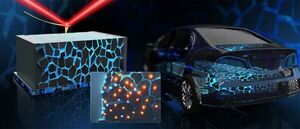
Metal trees in the battery
"Understanding how short-circuits occur in solid-state batteries could extend their lifespan They could be the next generation of battery: so-called ‘solid-state’ batteries. They’re made entirely of solid materials and have no liquid medium between their poles, as today's batteries do. These types of batteries could extend the range of electric cars and make them safer, as they can store more electricity and are less flammable. So far, however, they have suffered from limited lifetimes. A team from the Max Planck Institute for Polymer Research has studied the processes that reduce the lifespans. Its findings could help build longer-lasting solid-state batteries." [...]

Researchers capture elusive missing step in the final act of photosynthesis
"After decades of effort and help from SLAC's X-ray laser, scientists have finally seen the process by which nature creates the oxygen we breathe. Photosynthesis plays a crucial role in shaping and sustaining life on Earth, yet many aspects of the process remain a mystery. One such mystery is how Photosystem II, a protein complex in plants, algae and cyanobacteria, harvests energy from sunlight and uses it to split water, producing the oxygen we breathe. Now researchers from the Department of Energy’s SLAC National Accelerator Laboratory and Lawrence Berkeley National Laboratory, together with collaborators from Uppsala University, Humboldt University, and other institutions have succeeded in cracking a key secret of Photosystem II. Using SLAC’s Linac Coherent Light Source (LCLS) and the SPring-8 Angstrom Compact free electron LAser (SACLA) in Japan, they captured for the first time in atomic detail what happens in the final moments leading up to the release of breathable oxygen. The data reveal an intermediate reaction step that had not been observed before." [...]

Light amplification by stimulated emission from electrically driven colloidal quantum dots finally achieved
"In Nature article, Los Alamos National Laboratory team realizes long-sought capabilities for semiconductor nanocrystal light-amplification devices In a result decades in the making, Los Alamos scientists have achieved light amplification with electrically driven devices based on solution-cast semiconductor nanocrystals — tiny specs of semiconductor matter made via chemical synthesis and often called colloidal quantum dots. This demonstration, reported in the scientific journal Nature, opens the door to a completely new class of electrically pumped lasing devices — highly flexible, solution-processable laser diodes that can be prepared on any crystalline or non-crystalline substrate without the need for sophisticated vacuum-based growth techniques or a highly controlled clean-room environment. “The capabilities to attain light amplification with electrically driven colloidal quantum dots have emerged from decades of our previous research into syntheses of nanocrystals, their photophysical properties and optical and electrical design of quantum dot devices,” said Victor Klimov, Laboratory Fellow and leader of the quantum dot research initiative. “Our novel, ‘compositionally graded’ quantum dots exhibit long optical gain lifetimes, large gain coefficients and low lasing thresholds — properties that make them a perfect lasing material. The developed approaches for achieving electrically driven light amplification with solution-cast nanocrystals might help resolve a long-standing challenge of integrating photonic and electronic circuits on the same silicon chip and is poised to advance many other fields ranging from lighting and displays to quantum information, medical diagnostics and chemical sensing.” More than two decades of research Research over more than two decades has sought to achieve colloidal quantum dot lasing with electrical pumping, a prerequisite for its widespread use in practical technologies. Traditional laser diodes, ubiquitous in modern technologies, produce highly monochromatic, coherent light under electrical excitation." [...]

In a first, astronomers spot a star swallowing a planet
"Earth will meet a similar fate in 5 billion years. As a star runs out of fuel, it will billow out to a million times its original size, engulfing any matter — and planets — in its wake. Scientists have observed hints of stars just before, and shortly after, the act of consuming entire planets, but they have never caught one in the act until now. In a study appearing today in Nature, scientists at MIT, Harvard University, Caltech, and elsewhere report that they have observed a star swallowing a planet, for the first time. The planetary demise appears to have taken place in our own galaxy, some 12,000 light-years away, near the eagle-like constellation Aquila. There, astronomers spotted an outburst from a star that became more than 100 times brighter over just 10 days, before quickly fading away." [...]
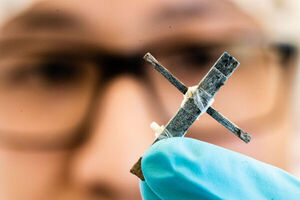
The world’s first wood transistor
"Researchers at Linköping University and the KTH Royal Institute of Technology have developed the world’s first transistor made of wood. Their study, published in the journal PNAS, paves the way for further development of wood-based electronics and control of electronic plants. Transistors, invented almost one hundred years ago, are considered by some to be an invention just as important to humanity as the telephone, the light bulb or the bicycle. Today, they are a crucial component in modern electronic devices, and are manufactured at nanoscale. A transistor regulates the current that passes through it and can also function as a power switch. Researchers at Linköping University, together with colleagues from the KTH Royal Institute of Technology, have now developed the world’s first electrical transistor made of wood." [...]

Researchers create a tool for accurately simulating complex systems
"The system they developed eliminates a source of bias in simulations, leading to improved algorithms that can boost the performance of applications. Researchers often use simulations when designing new algorithms, since testing ideas in the real world can be both costly and risky. But since it’s impossible to capture every detail of a complex system in a simulation, they typically collect a small amount of real data that they replay while simulating the components they want to study. Known as trace-driven simulation (the small pieces of real data are called traces), this method sometimes results in biased outcomes. This means researchers might unknowingly choose an algorithm that is not the best one they evaluated, and which will perform worse on real data than the simulation predicted that it should. MIT researchers have developed a new method that eliminates this source of bias in trace-driven simulation." [...]

Researchers detect and classify multiple objects without images
"High-speed method uses less computational power, could be useful for autonomous driving Researchers have developed a new high-speed way to detect the location, size and category of multiple objects without acquiring images or requiring complex scene reconstruction. Because the new approach greatly decreases the computing power necessary for object detection, it could be useful for identifying hazards while driving. “Our technique is based on a single-pixel detector, which enables efficient and robust multi-object detection directly from a small number of 2D measurements,” said research team leader Liheng Bian from the Beijing Institute of Technology in China. “This type of image-free sensing technology is expected to solve the problems of heavy communication load, high computing overhead and low perception rate of existing visual perception systems.” Today’s image-free perception methods can only achieve classification, single object recognition or tracking. To accomplish all three at once, the researchers developed a technique known as image-free single-pixel object detection (SPOD). In the Optica Publishing Group journal Optics Letters, they report that SPOD can achieve an object detection accuracy of just over 80%." [...]
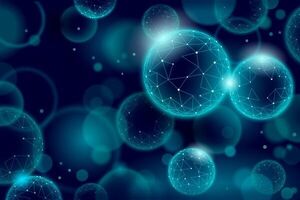
Scientists take an important step towards using quantum computers to advance materials science
"A team of scientists from the U.S. Department of Energy’s Ames National Laboratory demonstrated a way to advance the role of quantum computing in materials research with an adaptive algorithm for simulating materials. Quantum computers have potential capabilities far beyond today’s computers, and using an adaptive algorithm allows them to produce solutions quickly and accurately. Quantum computers have a completely different way of computing than the computers we use today. They are built of quantum bits, or qubits, which can encode much more information than the bits in today’s computers. These unique capabilities allow quantum computers to make calculations beyond what is currently possible with classical computers. A team of scientists at Ames Lab are working to harness the power of quantum computers to make materials research easier and more efficient." [...]
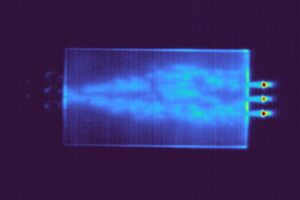
Lithography-Free Photonic Chip Offers Speed and Accuracy for Artificial Intelligence
"Photonic chips have revolutionized data-heavy technologies. On their own or in concert with traditional electronic circuits, these laser-powered devices send and process information at the speed of light, making them a promising solution for artificial intelligence's data-hungry applications. In addition to their incomparable speed, photonic circuits use significantly less energy than electronic ones. Electrons move relatively slowly through hardware, colliding with other particles and generating heat, while photons flow without losing energy, generating no heat at all. Unburdened by the energy loss inherent in electronics, integrated photonics are poised to play a leading role in sustainable computing. Photonics and electronics draw on separate areas of science and use distinct architectural structures." [...]

FAU physicists measure and control electron release from metals in the attosecond range
"By superimposing two laser fields of different strengths and frequency, the electron emission of metals can be measured and controlled precisely to a few attoseconds. Physicists from Friedrich-Alexander-Universität Erlangen-Nürnberg (FAU), the University of Rostock and the University of Konstanz have shown that this is the case. The findings could lead to new quantum-mechanical insights and enable electronic circuits that are a million times faster than today. The researchers have now published their findings in the journal Nature. Light is capable of releasing electrons from metal surfaces. This observation was already made in the first half of the 19th century by Alexandre Edmond Becquerel and later confirmed in various experiments, among others by Heinrich Hertz and Wilhelm Hallwachs." [...]

New chemistry can extract virgin-grade materials from wind turbine blades in one process
"The new chemical process is not limited to wind turbine blades but works on many different so-called fibre-reinforced epoxy composites, including some materials that are reinforced with especially costly carbon fibres. Thus, the process can contribute to establishing a potential circular economy in the wind turbine, aerospace, automotive and space industries, where these reinforced composites, due to their light weight and long durability, are used for load-bearing structures. Being designed to last, the durability of the blades poses an environmental challenge. Wind turbine blades mostly end up at waste landfills when they are decommissioned, because they are extremely difficult to break down. If no solution is found, we will have accumulated 43 million tonnes of wind turbine blade waste globally by 2050. The newly discovered process is a proof-of-concept of a recycling strategy that can be applied to the vast majority of both existing wind turbine blades and those presently in production, as well as other epoxy-based materials." [...]
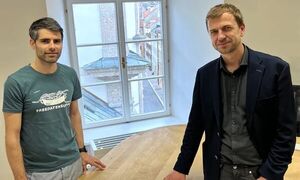
Quantum computer in reverse gear
"Today's computers are based on microprocessors that execute so-called gates. A gate can, for example, be an AND operation, i.e. an operation that adds two bits. These gates, and thus computers, are irreversible. That is, algorithms cannot simply run backwards. "If you take the multiplication 2*2=4, you cannot simply run this operation in reverse, because 4 could be 2*2, but likewise 1*4 or 4*1," explains Wolfgang Lechner, professor of theoretical physics at the University of Innsbruck." [...]
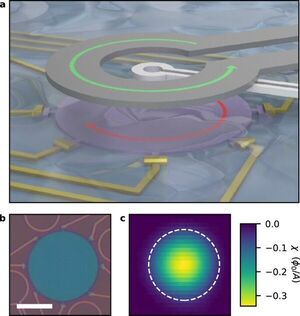
Magnetic imaging unlocks crucial property of 2D superconductor
"Using state-of-the-art magnetic imaging, a Cornell-led collaboration has for the first time characterized a key property of the superconducting state of a class of atomically thin materials that are too difficult to measure due to their minuscule size. The group’s paper, “Superfluid Response of an Atomically Thin Gate-Tuned van der Waals Superconductor,” published April 12 in Nature Communications. The lead author is doctoral student Alexander Jarjour. The project was led by Katja Nowack, assistant professor of physics in the College of Arts and Sciences and the paper’s senior author, whose lab investigates emergent phenomena and order in quantum materials via a range of scanning probes. The group’s superconducting quantum interference device, or SQUID, is particularly adept at working at low temperatures and in small magnetic fields. The researchers applied their SQUID – one of only several in the U.S. – to the inorganic compound molybdenum disulfide, which is known as a van der Waals material." [...]
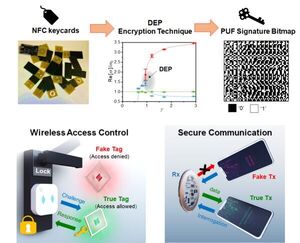
Using quantum physics to secure wireless devices
"From access cards and key fobs to Bluetooth speakers, the security of communication between wireless devices is critical to maintaining privacy and preventing theft. Unfortunately, these tools are not foolproof and information on how to hack, clone and bypass these systems is becoming easier to find. That’s why computer engineers at the University of Illinois Chicago have been investigating ways to create more secure devices. In a new paper, UIC scientists report a method inspired by quantum physics to improve wireless device identification and protect device-to-device communication. It uses a truly random and unique digital fingerprint to create a hardware encryption system that is virtually unbreakable. The scientists, led by Pai-Yen Chen, used a theory from quantum physics in math-based experiments to identify a “divergent exceptional point.” Quantum physics describes systems for which precise measurement is difficult or impossible; a quantum state describes a parameter space or range of possible measurements." [...]
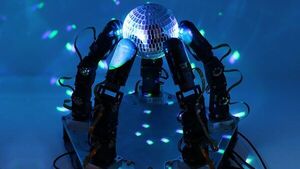
Highly Dexterous Robot Hand Can Operate in the Dark — Just Like Us
"Columbia Engineers design a robot hand that is the first device of its kind to join advanced sense of touch with motor-learning algorithms — it doesn’t rely on vision to manipulate objects Think about what you do with your hands when you’re home at night pushing buttons on your TV’s remote control, or at a restaurant using all kinds of cutlery and glassware. These skills are all based on touch, while you’re watching a TV program or choosing something from the menu. Our hands and fingers are incredibly skilled mechanisms, and highly sensitive to boot. Robotics researchers have long been trying to create “true” dexterity in robot hands, but the goal has been frustratingly elusive. Robot grippers and suction cups can pick and place items, but more dexterous tasks such as assembly, insertion, reorientation, packaging, etc. have remained in the realm of human manipulation." [...]
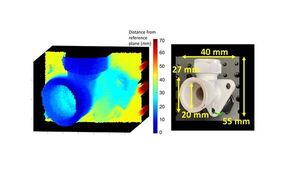
Quantum lidar prototype acquires real-time 3D images while fully submerged underwater
"Highly sensitive imaging approach could allow monitoring or surveillance in turbid water For the first time, researchers have demonstrated a prototype lidar system that uses quantum detection technology to acquire 3D images while submerged underwater. The high sensitivity of this system could allow it to capture detailed information even in extremely low-light conditions found underwater. “This technology could be useful for a wide range of applications,” said research team member Aurora Maccarone, a Royal Academy of Engineering research fellow from Heriot-Watt University in the United Kingdom. “For example, it could be used to inspect underwater installations, such as underwater wind farm cables and the submerged structure of the turbines. Underwater lidar can also be used for monitoring or surveying submerged archaeology sites and for security and defense applications.” Obtaining 3D images through ocean water can be challenging because it is light-limited, and any particles in the water will scatter light and distort the image. However, single-photon detection, which is a quantum-based technique, allows very high penetration and works even in low-light conditions." [...]

Optical neural networks hold promise for image processing
"Cornell researchers have developed an optical neural network (ONN) that can filter relevant information from a scene before the visual image is detected by a camera, a method that may make it possible to build faster, smaller and more energy-efficient image sensors. In “Image Sensing with Multilayer, Nonlinear Optical Neural Networks,” published March 23 in Nature Photonics, researchers in the lab of Peter McMahon, assistant professor of applied and engineering physics in Cornell Engineering, have been able to demonstrate that ONN pre-processors can achieve compression ratios of up to 800-to-1 — the equivalent of compressing a 1,600-pixel input to just 2 pixels — while still enabling high accuracy across several representative computer-vision tasks. Led by Tianyu Wang, an Eric and Wendy Schmidt AI in Science Postdoctoral Fellow, and doctoral student Mandar Sohoni, the researchers tested the ONN image sensor with machine-vision benchmarks, used it to classify cell images in flow cytometers, and further demonstrated its ability measure and identify objects in 3D scenes. The difference between digital systems and an optical neural network is that with digital systems, images are first saved and then sent to a digital electronic processor that extracts information. Such electronic processing is power-consuming and, more importantly, requires far more time for the data to be processed and interpreted. “Our setup uses an optical neural network, where the light coming into the sensor is first processed through a series of matrix-vector multiplications that compresses data to the minimum size needed — in this case, four pixels,” Wang said." [...]
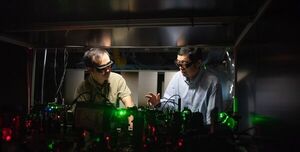
Quantum Entanglement of Photons Doubles Microscope Resolution
"Using a "spooky" phenomenon of quantum physics, Caltech researchers have discovered a way to double the resolution of light microscopes. In a paper appearing in the journal Nature Communications, a team led by Lihong Wang, Bren Professor of Medical Engineering and Electrical Engineering, shows the achievement of a leap forward in microscopy through what is known as quantum entanglement. Quantum entanglement is a phenomenon in which two particles are linked such that the state of one particle is tied to the state of the other particle regardless of whether the particles are anywhere near each other. Albert Einstein famously referred to quantum entanglement as "spooky action at a distance" because it could not be explained by his relativity theory. According to quantum theory, any type of particle can be entangled. In the case of Wang's new microscopy technique, dubbed quantum microscopy by coincidence (QMC), the entangled particles are photons." [...]
Projetos Maker
Diversos Projetos interessantes.

555 Timer Brushless DC Motor Driver Board
"In this project, our focus is to build a 555 Timer Brushless DC Motor Driver Board which will be based on the 555 Timer IC and the DRV10866. In this project, our focus is to build a 555 Timer Brushless DC Motor Driver Board which will be based on the 555 Timer IC and the DRV10866 IC. DC Brushless motors are used in computer support peripherals such as disk drives, handheld power tools, printers, automobiles, drones, and aircraft. DC Motors requires relevant information for it to be able to select the best angle and speed to drive the system. This is where the driver circuit comes in to play such a role. In most applications, we incorporate the Hall Effect Sensor but in our advanced system, we will build a board that can replace the sensor and perform well as expected." [...]
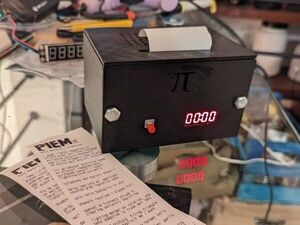
Piem Machine
"Calculate π decimals with Chudnovsky algorithm to generate long and strange poems, The world of π is vast and complex. Lot of people struggle to memorize Pi decimals for some reason. Current unofficial record is being held by a guy named Akari Haraguchi who memorized around 100.000 Pi decimals. How can he do such a thing? One common way to memorize Pi decimals is using something called Piems. What are Piems?" [...]
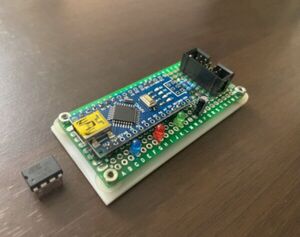
Building 'Arduino As ISP' Using Arduino Nano to Program ATtiny85
"Unlike some other microcontrollers, such as the Arduino Uno, the ATtiny85 does not have a built-in USB interface for programming. Instead, it requires an external programmer to load the program code onto the microcontroller's flash memory. ATtiny85 has a different programming protocol than the Arduino Uno, which uses a bootloader to enable programming over USB. The ATtiny85 uses a protocol called In-System Programming (ISP), which requires a dedicated programmer to interface with the microcontroller's programming pins. ATtiny85 has a smaller pin count than the Arduino Uno, and its pins are multipurpose, which means that they can be used for both programming and general input/output. This makes it more challenging to use a single USB interface for both programming and communication with external devices." [...]

Simple ESP8266 NTP Clock on VFD Display VFD256x50 GP1287
"Simple way to make a ESP8266 clock on a VFD display that synchronizes the exact time through NTP time servers on the Internet. A VFD (Vacuum Fluorescent Display) is an electronic display device that is commonly used for displaying numeric or alphanumeric characters. It is similar to an LCD (Liquid Crystal Display) but uses a different technology to display information. VFD displays are known for their high brightness, high contrast, and wide viewing angle, making them suitable for use in a variety of applications, including digital clocks. Exactly such a clock is described in this video. Unfortunately, I could not get a datasheet or any more detailed information from the supplier, except that it is compatible with an STM32 microcontroller, which for me meant that it can be easily connected to other microcontrollers such as Arduino." [...]
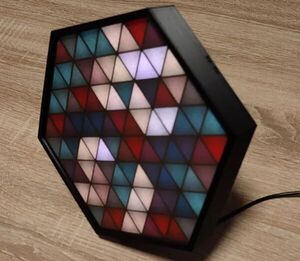
Creating a Stylish Triangular Pixels LED Clock Using WS2812 Leds and Wemos D1 Mini Module
"Clocks are an essential part of our daily routine that help us manage time effectively and stay on track. Clocks can help regulate our sleep patterns and ensure that we meet our deadlines. They not only serve a functional purpose but also enhance the decor of our homes. In the next article, I will explore the construction of a LED clock, which combines functionality and style, making it a fun DIY project for those interested in electronics and design. I wanted to make a special gift for our dear family members, and I searched extensively for something beautiful and unique. And since every home needs a special clock, I finally found exactly what I wanted." [...]

BQ25896 ATMega32U4 Lithium Battery Charger with Powerbank
"An advanced lithium battery charger and powerbank with a SSD1306 OLED display, charges 18650, 20700 and 21700 batteries. Story I wanted to make a battery charger that was not based on the popular Chinese TP4056 IC that you see all over the internet. So after some research I came across the Texas Instruments BQ25896, this is a single cell 3A charger that can be controlled using I2C, it also has a boost mode and can turn the connected battery into a powerbank delivering up to 2A of current. This charger IC is typically used in mobiles and I did not hand solder it, all the other standard SMD components were hand soldered. The charger IC is controlled using an ATMEGA32U4 microcontroller, the main code was written using the Arduino IDE 2.x and the driver library was coded using Visual Studio. The features and functions of this device are: - Adjustable charge voltage and current with a battery store mode - Adjustable boost voltage and current - SSD1306 OLED display - Rotary encoder for menu selection - Low battery charge mode - Reverse battery polarity protection using MOSFETs - 3 AMP Fast Charge current and 2 AMP powerbank output - USB C, Type A and Micro ports - NTC thermistors for the battery and IC temperature monitoring - ICSP header - Buzzer for audio feedback - Low power mode and full auto power off mode - Heatsink to dissipate the 3 AMP of charging switching loss - WS2812B indicator LEDs" [...]

Arduino Wi-Fi AC Energy Meter
"Introducing an accurate AC energy meter that is Wi-Fi enabled. The meter has a power range of 5W to 3.2kW and measures True RMS volts, True RMS current, Real power, Power factor, kilowatt-hours and includes a scrolling plot of AC voltage variation over time. All data is sent once every second via Wi-Fi to a free Android App called "RoboRemo". For this project we will utilize an Arduino Nano, an 8266-01 Wi-Fi module and an ACS712 current sensing module. This instructable will explore the theory behind AC power measurements , explain how the circuit works and show how to download and customize the RoboRemo application. Supplies - Arduino Nano - Note: an Arduino UNO or MEGA can be substituted - ESP8266-01 module - ACS712-20 - Current sense module - 5V Power Supply (500mA min) - I used a small 5V USB Charger - LMC7111 - Op-Amp rail to rail Note: LM321,LM324 or M358 can be substituted limiting the dynamic range of ACS712 - LM78M33 - 3.3V regulator SOT-223 package Note: Any suitable 3.3V regulator can be substituted - 220k resistor 1Watt - 10K resistor (x5) - 2.7k resistor (x2) - 1k resistor (x3) - 1uF electrolytic capacitor (x2) 10 volts or greater - 100nF ceramic capacitor (x3) - Pin Header strip - Female - Terminal block 5mm 2 pin (x4) - AC lamp cord wire - small guage hook-up wire" [...]
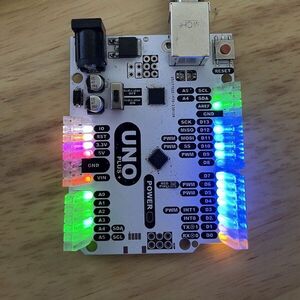
Uno Plus+
"An Arduino UNO Compatible Board with isolated Glowing headers and some Extras If its not broken don't fix it, just add some more features. The Uno Plus+ is An Arduino Uno Compatible Board with a twist. All the components are on the bottom giving ample space to clearly label all the pins and even label the second and third function. The Goal of the Uno Plus+ it to take the Arduino Uno, and make it even easier to use. An by adding isolated LED indicators on the IO Pins Debugging and Teaching can be even easier for teachers and student in the STEM Field. With the addition of a Stemma/Quiic connector and an integrated addressable LED can speed the process of developing a Project." [...]
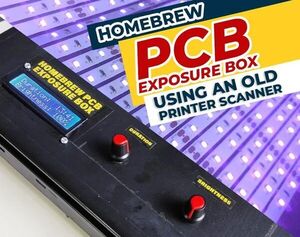
Homebrew PCB Exposure Box Using an Old Printer Scanner!
"Did you know that we can create a homebrew PCB exposure box using an old printer scanner? Yes you read it right! The Problem: In my experience, the quality of the presensitized method for making homebrew PCBs is really impressive, especially when you are dealing with tiny traces. Now, the presensitized method needs to be exposed to UV light for a certain amount of time; that means it won't etch well if it gets overexposed or underexposed. Ever since, I've been using my fluorescent lamp to expose the PCBs, but we are going to change that starting today! Here are the things that you will need, you'll need a 12 volt power supply, two 10k potentiometers, an i2c 16x2 LCD, a resistors, a buzzer, an Arduino nano, a TIP 31C transistor, a UV LED strip, a momentary switch, a female DC power jack, a header pin, and lastly, the star of the show, which is the old printer." [...]

R2D2 Mini Edition
"So here's something special, A Mini R2D2 PCB that speaks Astromech. Astromech is a fictional language in the star wars franchise consisting of whistles and beeps. This Mini R2D2 that I made is a Keychain. Its brain is an Attiny85 and is powered by a CR2032 Coin Cell holder. I was inspired by this Instructables- https://www.instructables.com/R2D2-Sound-Generator/ MarceloLarios made a simple Arduino Uno setup that produces random beeps every 3 seconds. I took the concept and prepare the whole thing by using an Attiny85 with a standalone circuit instead of using a whole Arduino UNO." [...]
Secção Videos
Videos interessantes.
That's all Folks!



